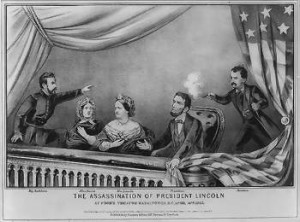04.14
On April 14, 1865, John Wilkes Booth, a famous actor and Confederate sympathizer, fatally shot President Abraham Lincoln at a play at Ford’s Theatre in Washington, D.C. The attack came only five days after Confederate General Robert E. Lee surrendered his massive army at Appomattox Court House, Virginia, effectively ending the American Civil War.
Booth learned that Lincoln was to attend Laura Keene’s acclaimed performance of “Our American Cousin” at Ford’s Theatre in Washington, D.C., on April 14, Booth—himself a well-known actor at the time—masterminded the simultaneous assassination of Lincoln, Vice President Andrew Johnson and Secretary of State William H. Seward. By murdering the president and two of his possible successors, Booth and his co-conspirators hoped to throw the U.S. government into disarray.
Lincoln occupied a private box above the stage with his wife Mary, a young army officer named Henry Rathbone and Rathbone’s fiancé, Clara Harris, the daughter of New York Senator Ira Harris. Lincoln occupied a private box above the stage with his wife Mary, a young army officer named Henry Rathbone and Rathbone’s fiancé, Clara Harris. The Lincolns arrived late for the comedy, but the president was reportedly in a fine mood and laughed heartily during the production.
At 10:15, Booth slipped into the box and fired his .44-caliber single-shot derringer into the back of Lincoln’s head. After stabbing Rathbone, who immediately rushed at him, in the shoulder, Booth leapt onto the stage and shouted, “Sic semper tyrannis!” (“Thus ever to tyrants!”–the Virginia state motto). At first, the crowd interpreted the unfolding drama as part of the production, but a scream from the first lady told them otherwise. Although Booth broke his leg in the fall, he managed to leave the theater and escape from Washington on horseback.
A 23-year-old doctor named Charles Leale was in the audience and hastened to the presidential box immediately upon hearing the shot and Mary Lincoln’s scream. He found the president slumped in his chair, paralyzed and struggling to breathe. Several soldiers carried Lincoln to a house across the street and placed him on a bed. When the surgeon general arrived at the house, he concluded that Lincoln could not be saved and would die during the night. Vice President Andrew Johnson, members of Lincoln’s cabinet and several of the president’s closest friends stood vigil by Lincoln’s bedside until he was officially pronounced dead at 7:22 a.m. The first lady lay on a bed in an adjoining room with her eldest son Robert at her side, overwhelmed with shock and grief.
The president’s body was placed in a temporary coffin, draped with a flag and escorted by armed cavalry to the White House, where surgeons conducted a thorough autopsy. Edward Curtis, an Army surgeon in attendance, later described the scene, recounting that a bullet clattered into a waiting basin during the doctors’ removal of Lincoln’s brain. He wrote that the team stopped to stare at the offending weapon, “the cause of such mighty changes in the world’s history as we may perhaps never realize.” During the autopsy, Mary Lincoln sent the surgeons a note requesting that they clip a lock of Lincoln’s hair for her.
News of the president’s death traveled quickly and by the end of the day flags across the country flew at half-mast, businesses were closed and people who had recently rejoiced at the end of the Civil War now reeled from Lincoln’s shocking assassination.
The president’s corpse was taken to the White House, and on April 18 it was carried to the Capitol rotunda to lay in state on a catafalque. On April 21, Lincoln’s body was boarded onto a train that conveyed it to Springfield, Illinois, where he had lived before becoming president. Tens of thousands of Americans lined the railroad route and paid their respects to their fallen leader during the train’s solemn progression through the North. Lincoln and his son, Willie, who died in the White House of typhoid fever in 1862, were interred on May 4, 1865, at Oak Ridge Cemetery, near Springfield.
As the nation mourned, Union soldiers were hot on the trail of John Wilkes Booth, who many in the audience had immediately recognized. After fleeing the capital, he and an accomplice, David Herold, made their way across the Anacostia River and headed toward southern Maryland. The pair stopped at the home of Samuel Mudd, a doctor who treated Booth’s leg. (Mudd’s actions earned him a life sentence that was later commuted). They then sought refuge from Thomas A. Jones, a Confederate agent, before securing a boat to row across the Potomac to Virginia.
On April 26, Union troops surrounded the Virginia farmhouse where Booth and Herold were hiding out and set fire to it, hoping to flush the fugitives out. Herold surrendered but Booth remained inside. As the blaze intensified, a sergeant shot Booth in the neck, allegedly because the assassin had raised his gun as if to shoot. Carried out of the building alive, he lingered for three hours before gazing at his hands and uttering his last words: “Useless, useless.” Four of Booth’s co-conspirators were convicted for their part in the assassination and executed by hanging on July 7, 1865. They included David Herold and Mary Surratt, the first woman put to death.












